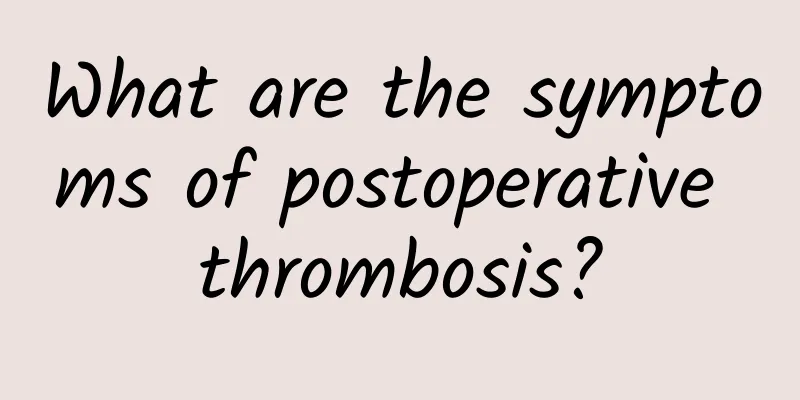What are the symptoms of postoperative thrombosis?

|
It is also common to cause blood clots after surgery. Patients often suffer from lower limb venous thrombosis, which can cause swelling and pain in the lower limbs and a local feeling of heaviness. At this time, the pain will worsen when walking or standing, which is quite harmful to patients. If you do not pay attention to timely treatment and prevention, it may also cause pulmonary embolism, which is a more serious manifestation of the disease. What are the symptoms of postoperative thrombosis? 1. Venous thrombosis is a common thrombosis in clinical practice, usually caused by slow blood flow or congestion. The characteristics of venous thrombosis are that it contains a large number of red blood cells and fibrin, and the platelets show aggregation and degranulation changes, and their number is small; the thrombus looks like a whole blood clot in a test tube, and its color is dark red, and it is called a red thrombus. Venous thrombosis often causes occlusion of the vascular lumen, so the proximal end of the thrombus is mainly composed of red blood cells, and the tail end often has new platelets adhered to the surface. 2. Arterial thrombosis, also known as white thrombus, is mainly composed of platelets and fibrin. It usually occurs in areas where blood flow is faster and the blood vessel wall is damaged, or in areas where the blood vessels are abnormal. Platelets only adhere to the diseased blood vessel walls to form platelet thrombi. When blood passes through, fibrin may be formed locally and attached to the surface of the platelet thrombi. 3. Microcirculatory thrombosis is a fibrin thrombus mainly composed of fibrin deposition, also known as transparent thrombus. Microvascular thrombosis can cause intravascular coagulation due to microcirculatory disorders; it can also be caused by the blockage of small blood vessels by detached emboli, or by direct damage to microvascular endothelial cells due to certain factors, leading to fibrin deposition. Common ones include DIC, hemolytic uremic syndrome, and thrombotic thrombocytopenic purpura.Postoperative thrombosis prevention 1. For high-risk groups that are prone to deep vein thrombosis of the lower limbs, such as obese patients, patients with a history of lower limb trauma, the elderly, patients who are bedridden for a long time, and patients with hypertension and diabetes, a targeted plan should be developed based on the pre-operative evaluation. If necessary, blood-activating or anticoagulant drugs should be given as soon as possible, and coagulation function monitoring should be strengthened. 2. Strengthen postoperative care. If the patient needs to stay in bed, he should be turned over frequently in the early stage and encouraged to carry out activities in bed, such as deep breathing, effective coughing, frequent active activities of the feet and toes, and flexion and extension of the lower limbs, etc., to reduce venous blood stasis. High-risk patients should raise their lower limbs 20-30 degrees to promote blood return, and wear medical elastic stockings on their lower limbs if necessary. 3. Unless there are special circumstances, the patient should get out of bed and move around as soon as possible after surgery. Generally, he or she can sit up on the edge of the bed and move his or her limbs 2 to 3 days after surgery, and then gradually increase the amount of activity. 4. Strengthen dietary care. It is advisable to eat light, low-salt, low-fat foods rich in vitamins, high in protein and high in fiber to prevent constipation, so as to avoid increased intra-abdominal pressure due to difficulty in defecation and affect venous return in the lower limbs. |
<<: How to overcome the fear of swimming
>>: The fastest way to eliminate blood clots
Recommend
Causes and clinical manifestations of Hashimoto's encephalopathy
Hashimoto's encephalopathy, also known as thy...
My milk is swollen but I can't squeeze it out
The phenomenon of milk engorgement is very common...
The cause of small red spots on the body
If you want to have a healthy body, you also need...
What is the function of Jianjing point?
We all know that there are many acupoints in the ...
When should I do prenatal glucose tolerance test?
The glucose tolerance test is a relatively import...
What causes anorexia? 4 common causes
Many man-made factors can cause anorexia, such as...
What to do if milk blockage and fever occur
For the health of their babies, many mothers choos...
Rupture of heart arteries is caused by these reasons!
The incidence of heart artery rupture is rising s...
Is cupping a good way to lose weight?
Cupping for weight loss is a very popular way to ...
How to identify baby's scissor legs
From conception to birth, every step of the baby&...
Sequelae of stroke
There are many sequelae of cerebral stroke, which...
Six taboos to remember when taking Chinese medicine
People in ancient times have long recognized that...
What medicine works fastest for colds?
Although a cold is not a serious illness, it give...
Facial eczema diet
Eczema is a common skin disease. Once eczema appe...
What to do if a child sprains his wrist? Emergency treatment should be appropriate
Wrist sprain is a very common disease. Due to lac...









